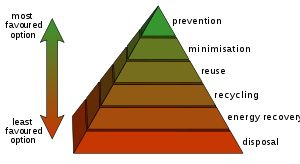Waste hierarchy
From Wikipedia, the free encyclopedia
| 3R Concepts |
|---|
The waste hierarchy refers to the 3Rs of reduce, reuse and recycle, which classify waste management strategies according to their desirability. The 3Rs are meant to be a hierarchy, in order of importance.[1]
The waste hierarchy has taken many forms over the past decade, but the basic concept has remained the cornerstone of most waste minimisation strategies. The aim of the waste hierarchy is to extract the maximum practical benefits from products and to generate the minimum amount of waste.
Some waste management experts[who?] have recently incorporated a 'fourth R': "Re-think", with the implied meaning that the present system may have fundamental flaws, and that a thoroughly effective system of waste management may need an entirely new way of looking at waste. Some "re-think" solutions may be counter-intuitive, such as cutting fabric patterns with slightly more "waste material" left -- the now larger scraps are then used for cutting small parts of the pattern, resulting in a decrease in net waste. This type of solution is by no means limited to the clothing industry. Source reduction involves efforts to reduce hazardous waste and other materials by modifying industrial production. Source reduction methods involve changes in manufacturing technology, raw material inputs, and product formulation. At times, the term "pollution prevention" may refer to source reduction.
Another method of source reduction is to increase incentives for recycling. Many communities in the United States are implementing variable rate pricing for waste disposal (also known as Pay As You Throw - PAYT) which has been effective in reducing the size of the municipal waste stream.[2]
Source reduction is typically measured by efficiencies and cutbacks in waste. Toxics use reduction is a more controversial approach to source reduction that targets and measures reductions in the upstream use of toxic materials. Toxics use reduction emphasizes the more preventive aspects of source reduction but, due to its emphasis on toxic chemical inputs, has been opposed more vigorously by chemical manufacturers. Toxics use reduction programs have been set up by legislation in some states, e.g., Massachusetts, New Jersey and Oregon. It is very important for the environment
[edit] See also
[edit] References
- ^ "Sustainability is an attitude, says new coordinator". UTSC. http://webapps.utsc.utoronto.ca/ose/story.php?id=628. Retrieved on 2007-10-09.
- ^ Mark Ruzzin. "Pay-As-You-Throw - Let's Start". http://www.ecocycle.org/zero/pay_throw.cfm. Retrieved on 2006-11-26.
[edit] External links
- Letsrecycle News Article on European Debate on Waste Hierarchy
- Getting to Zero Waste



